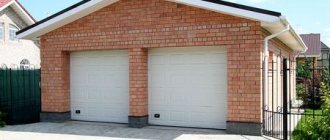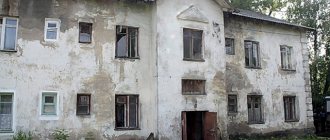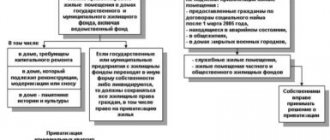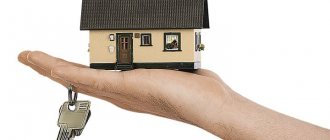Who can decide whether to recognize houses as unsafe?
The new rules are outlined in the Decree of the Government of the Russian Federation dated April 24, 2020 No. 581 “On amending paragraph 7 of the Regulations on recognizing premises as residential premises, residential premises unsuitable for habitation, an apartment building in disrepair and subject to demolition or reconstruction, a garden house as a residential building and a residential building garden house."
Question and answer How can residents of a dilapidated house stop paying for major repairs?
In this document, the government clarified who makes the decision to recognize a residential premises as unfit for habitation, and an apartment building as unsafe and subject to demolition or reconstruction.
The resolution states that if an assessment is carried out on objects of the housing stock of the Russian Federation, as well as an apartment building located in federal ownership, then the decision is made by the federal executive body exercising the powers of the owner of the property. If the property belongs to a federal executive body or its subordinate enterprise (institution), then the decision is made by this body.
Which apartment buildings are considered unsafe?
The grounds for recognizing an apartment building as unsafe and subject to demolition or reconstruction are listed in Decree of the Government of the Russian Federation dated January 28, 2006 N 47. This is the emergency technical condition of its load-bearing building structures or the apartment building as a whole. It is characterized by damage to load-bearing structures and their deformations, which indicate the exhaustion of the load-bearing capacity and the danger of collapse of an apartment building, or tilting, which can cause a loss of stability of the house.
In addition, apartment buildings located in dangerous zones of landslides, mudflows, snow avalanches, as well as in areas that are annually inundated by flood waters and in which it is impossible to prevent flooding using engineering and design solutions are recognized as unsafe. Those apartment buildings that are located in the zone of probable destruction during man-made accidents are also recognized as emergency if it is impossible to prevent the destruction of residential premises using engineering and design solutions.
If an apartment building has been declared unsafe and subject to demolition or reconstruction, then its residential premises are unsuitable for habitation.
Legal requirements for the procedure
Is it possible to privatize emergency housing? Article 4 of the law “On Privatization...” contains a direct prohibition on the transfer into the ownership of citizens of residential premises located in unsafe buildings.
If a residential building is officially recognized as unsafe, an apartment in it cannot be privatized even through the court.
How to privatize dilapidated housing? Due to the absence of the concept of dilapidated housing in the law, its privatization is possible. Where to begin? Privatization in this case is carried out as usual .
Submitting an application to the administration that owns the housing. The basis for privatization is the social tenancy agreement, on the basis of which the tenants moved into the apartment.
The application is signed by all citizens registered at this address, as well as those persons who are included in the rental agreement, but do not currently live in the apartment. The application is accompanied by a package of documents :
- Registered passports or birth certificates of minors (copies).
- Information about those registered in the living space.
- Lease agreement. In case of his absence, a move-in order is provided.
- Technical documentation of housing.
Notarized refusals from privatization (if there are persons registered in the apartment, but who do not want to receive its share).
If the refusal is issued by citizens from 14 to 18 years of age, permission from the guardianship authorities will be required.Children under 14 years of age receive a share in residential premises without fail, so a waiver cannot be issued on their behalf.
- Certificate Form No. 9 (from citizens who checked out of the apartment from the moment they moved in until the moment they submitted the application).
- Certificates of change of surname (if available).
- Power of attorney for privatization (if any of those registered cannot participate in the procedure in person).
- Certificates of non-participation in privatization (read our article about the possibility of repeated participation).
- Receipt for payment of state duty (1000 rubles per person).
After reviewing the documents, the owner of the premises draws up an agreement for the transfer of residential premises into the ownership of citizens. All future owners of shares in the premises, excluding those who refuse, must appear at the same time to sign the document.
The signed Privatization Agreement is transferred to Rosreestr to obtain a Certificate of Ownership . When submitting an application to Rosreestr, all parties to the agreement must also be present.
Based on the results of registration, all parties to the agreement receive Certificates of ownership of shares in the apartment.
You can submit an application for privatization through the MFC. The procedure for submitting an application and further processing of documents is identical to that described earlier.
The difference is that all the necessary documents can be obtained using the “one window” principle directly from this organization.
Tenants of dilapidated housing have every right to privatize it if the premises do not have emergency status. The refusal of officials to conclude an agreement can be appealed in court.
What residential premises are considered unfit for habitation?
According to the law, the basis for declaring a residential premises unfit for habitation is the presence of identified harmful factors in the human environment that do not ensure the safety of life and health of citizens. The reasons cited are the physical wear and tear of the building during its operation, as well as changes in the environment and microclimate parameters of the housing.
Question answer
Which housing is considered equivalent and which is considered equivalent?
For example, premises located in houses located in areas where sanitary and epidemiological safety indicators in terms of noise, vibration, electromagnetic and ionizing radiation, concentration of chemical and biological substances in the atmospheric air and soil, established by law, are considered unsuitable. Also, this is the location of the premises in areas adjacent to overhead AC power lines and other objects that create, at a height of 1.8 m from the surface of the earth, an electric field strength of an industrial frequency of 50 Hz of more than 1 kV/m and a magnetic field induction of an industrial frequency of 50 Hz of more than 50 µT
A complete list of criteria by which premises can be considered unsuitable for habitation is contained in Decree of the Government of the Russian Federation dated January 28, 2006 N 47.
What is the procedure for recognizing housing as unsafe?
Previously, houses were recognized as unsafe based on a decision of an interdepartmental municipal commission. In accordance with the Decree of the Government of the Russian Federation of November 29, 2020 No. 1535 “On amendments to the Regulations on recognizing premises as residential premises, residential premises unsuitable for habitation...”, an examination is now required for the conclusion. It is carried out by specialized organizations that have the right to carry out work to examine the condition of the soils of the foundations of buildings, structures and their building structures.
Subsequently, the interdepartmental commission, within three days, sends the results of the examination to the relevant federal government body, the executive body of the constituent entity of the Russian Federation, as well as the local government body for decision-making. In addition, the results of the examination are received by the applicant and (or) the state housing supervision body (municipal housing control) at the location of the premises or apartment building.
Resettlement of apartments: question and answer
How will Khrushchev apartments be resettled in St. Petersburg: by apartment area or social norms? We have a four-room apartment, 43 sq. m. m. residential and 59 sq. m. total area. Family of four: husband, wife, 16-year-old daughter and 19-year-old son. What can we get the maximum and minimum under the terms of employment? What will the owner get in our case? Is it profitable for us to privatize an apartment?
If the apartment is not privatized, then you must receive a comfortable apartment (any type of building and area of the city), with an area no less than that of the apartment from which you are being evicted. Those. You must be given a 3-room apartment (the number of rooms is determined by the composition of your family) with a total area of at least 59 square meters. m. If you own the apartment, they will offer you the same thing, and if you refuse, the court will determine the market value of the apartment, force you to pay this money and evict you from the apartment. If you agree, you will be provided with an alternative apartment on the right of ownership. So there is no fundamental difference depending on the ownership of the apartment. However, privatization ends in the summer of 2010. So, if you are not resettled in the coming years, it is still better to privatize the apartment.










